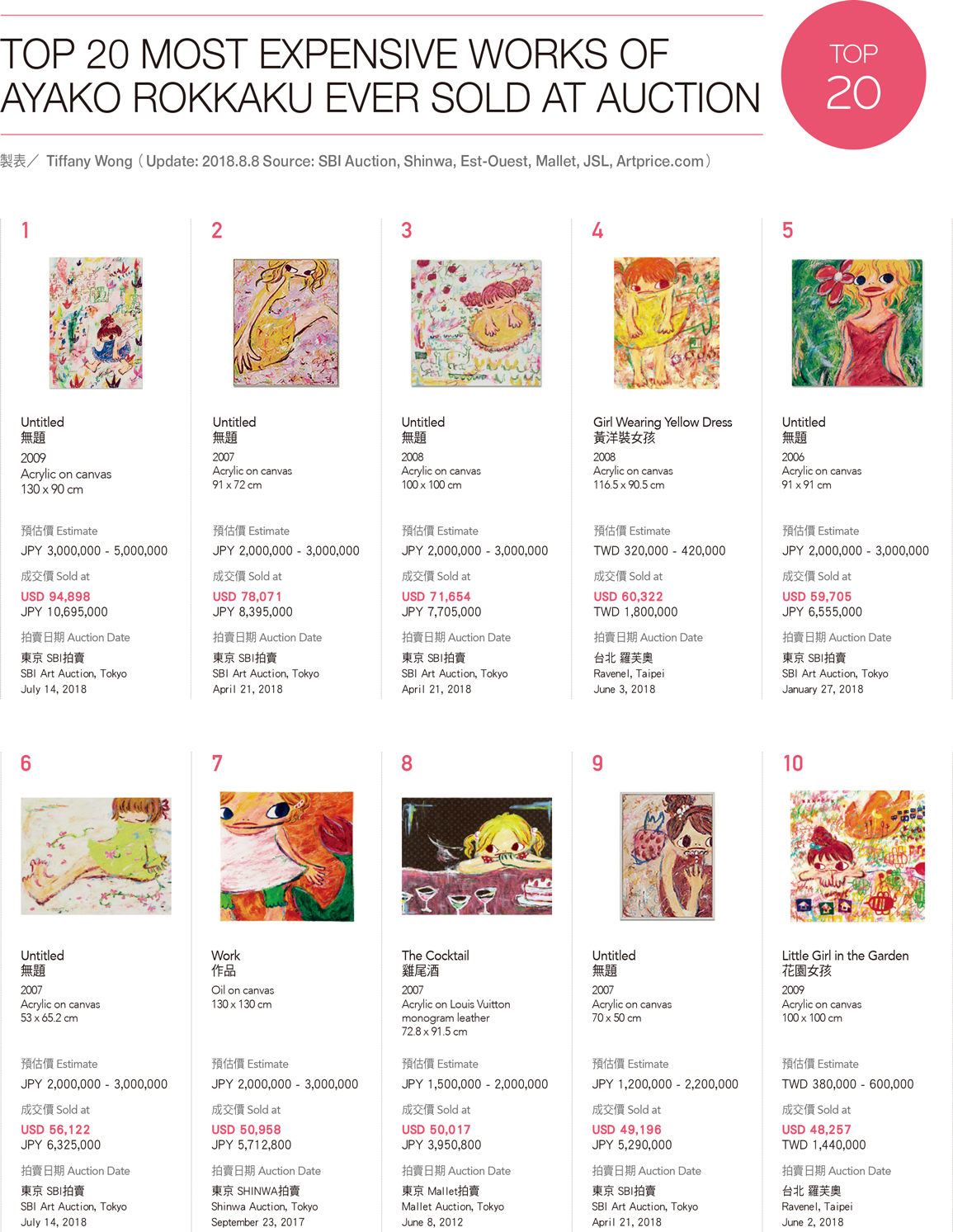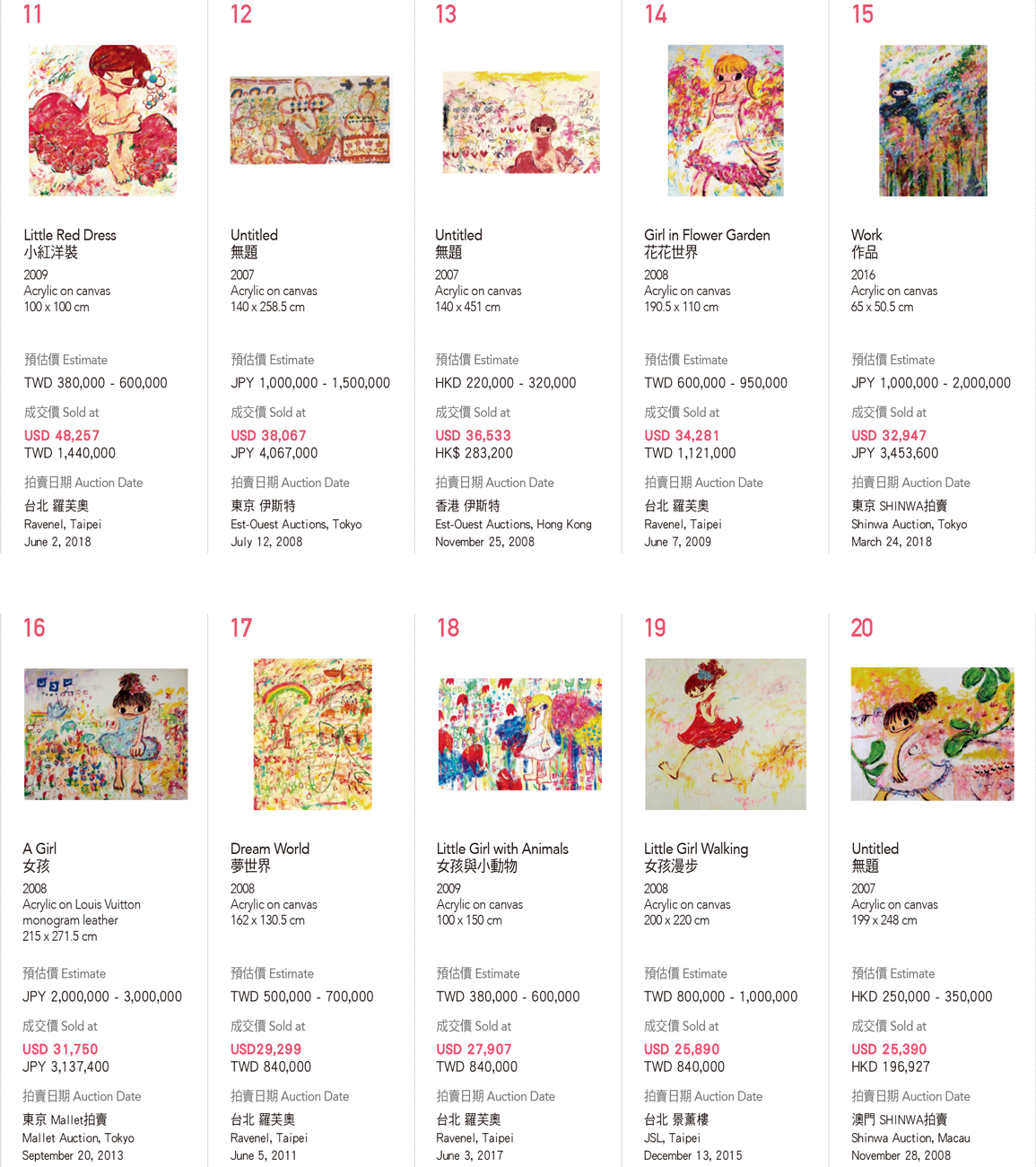Art Column
AYAKO ROKKAKU: A HAND-PAINTED WORLD OF DREAMS
Odile Chen / Ravenel Quarterly No. 26 Autumn 2018 / 2018-09-18
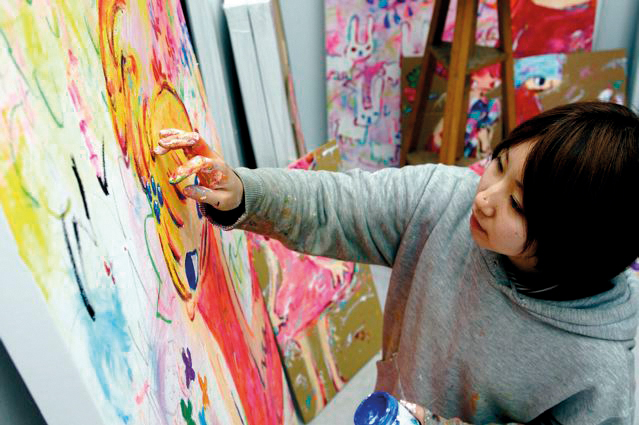
In recent years, works by the Japanese contemporary artist Yoshitomo Nara have been attracting increasingly higher bids. In Autumn 2015, one of his oil paintings was sold for US$3.413 million in New York (approximately NT$100 million). His 3D sculptures were sold for over US$1 million. And, under fierce competition among collectors, his incomparably therapeutic works on paper and limited prints were also sold for over NT$10 million. Similarly, products ornamented with her artwork such as suitcases, radios, and posters, and peripheral products at his exhibitions have all sold in great demand on auction markets around the world. As a result, the art market in Asia has been speculating on who will be the next Nara. Among the various possibilities, the most popular guess is the Japanese contemporary artist Ayako Rokkaku.
In 2018, the popular rumor on the market was that “Ayako Rokkaku is the next Yoshitomo Nara," leading to heated bidding on Rokkaku´s works. Be they works on paper or oil paintings, all of her works at auctions attracted bids several times higher than the expected price. In fact, the market value of her works peaked once in 2009, and the first time her works appeared at auction can be traced back to 2007 in Tokyo, showing that Rokkaku is by no means a newcomer to the market.
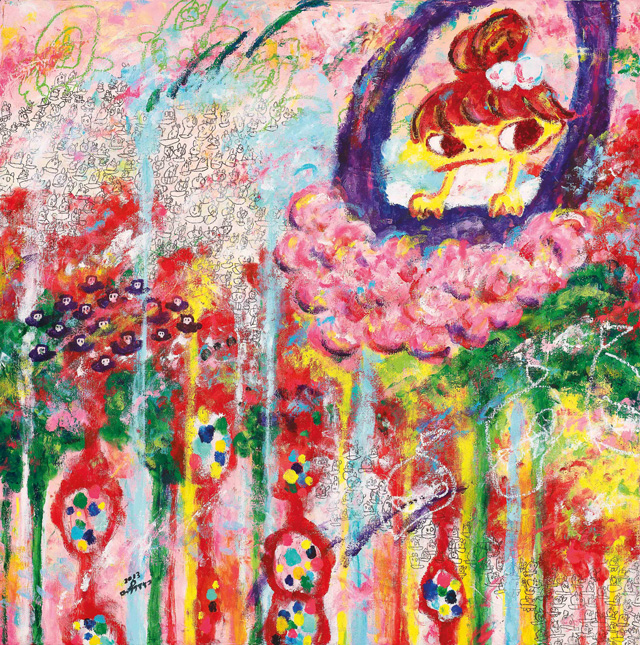
AN ARTIST APPECIATED BY TAKASHI MURAKAMI
Ayako Rokkaku was born in January 24, 1982, in Chiba Prefecture, Japan. Chiba Prefecture, which is close to Tokyo, is the home of the airport of the capital of Japan, Narita International Airport, and the children’s paradise, Disneyland. Rokkaku’s background is similar to that of the prefecture in that this world seems to have foretold her future of soaring through the skies and traveling among the cities of the world and a dreamland for girls she is an expert at portraying.
After graduating from high school, Rokkaku studied in the department of illustration at a vocational school, graduating at the age of 20. After graduating, she could not find a job that suited her. She participated in art design events and started on-site live creation. In 2001, when she was nearly 20, Rokkaku started creating at home, in the park, or on the street. She enjoyed observing nature, feeling the trees and grass waving in the breeze under the sun. She chatted with the crowds gathered around her when she painted in the park, and sometimes they purchased her works. Those buyers were not authentic art collectors; they made purchases out of sheer appreciation. Some people asked her to paint portraits of their pet dogs. Rokkaku was not good at refusing others, so even though she humbly mocked herself for not being good at painting portraits, she still tried hard to produce cute dog portraits.
In 2003, Rokkaku participated in the fourth GEISAI art festival. Her paintings of girls with huge heads and large eyes on abandoned cardboard caught the judges’ attentions and won her the Scout Prize. In 2006, she participated in the ninth GEISAI. Her more intricate and colorful portraits of girls won her the Goto Akio Prize. Soon, in the tenth GEISAI, she snatched the Smart Prize and attracted attention from international mainstream galleries.
The Japanese word GEISAI means art festival; it is the abbreviation of “geijutsusai,” meaning “arts festival.” The inspiration of this event originated from the school festivals of arts schools. The Japanese contemporary artist Takashi Murakami has the mentality of a businessman. His company “Kaikai KiKi” hosted the GEISAI. GEISAI was previously the Geijitsu doujou GP, whose purposes were to discover emerging artists and establish a free trade market. Murakami gathered famous people for the panel of judges and attracted over 200 artists to sign up for the fair, causing a sensation. In 2002, the fair was officially named “GEISAI,” and the scope expanded each year. Participants consider GEISAI a stage where they can win instant fame. In this competition, which provides professional word-of-mouth
and affirmation, young artists can get the chance to host solo exhibitions.
Strictly speaking, Rokkaku was not trained in academia. However, she is gifted in sketching and in her creativity, which enabled her to stand out among numerous participants. She developed a skill to paint not with brushes but directly with her hands. This improvisational behavior calls to mind the Japanese Gutai masters. Her paintings constantly being nominated for awards is not a coincidence.
If she did not demonstrate a strong personal style, she would not have been able to attract the professional judges’ attention. The judges of the ninth GEISAI included heavyweight professionals on the art scene, notably François Pinault, the famous collector and owner of the international auction house Christie’s; Tadao Ando, an architect; and painter Makoto Aida.
“The hand directs where the fingers point. They are more powerful than words.”
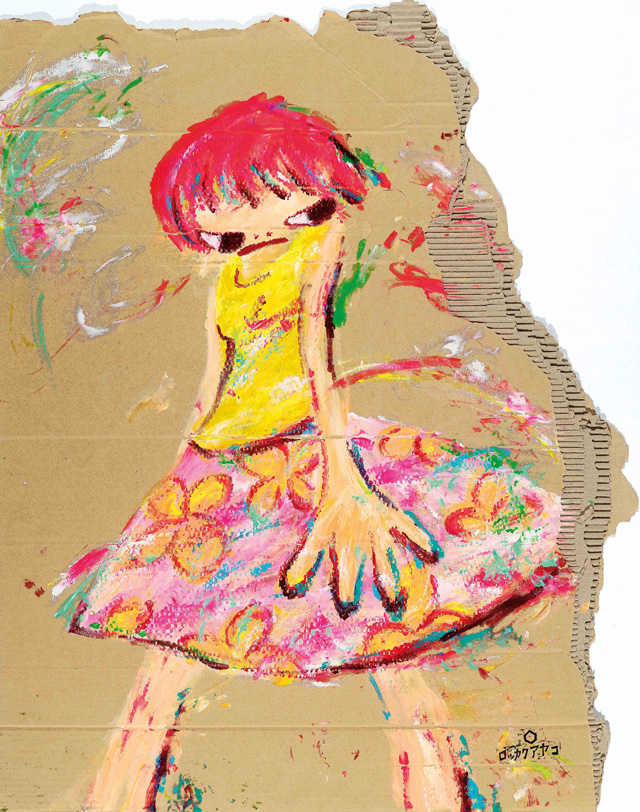
THE GIRL HOVERING AMONG JAPAN, AMSTERDAM, AND BERLIN
Since Rokkaku repeatedly won awards at GEISAI, in 2006, she was presented with the opportunity to participate in exhibitions in Switzerland, France, and the United States. Moreover, the Dutch art dealer Nico Delaive offered to be her global representation. Gallery Delaive was founded in late 1970s. Since the 1980s, it has established its reputation through promoting Karel Appel, one of the CoBrA Group artists; Walasse Ting; and the French female artist Niki de Saint Phalle. It is also the only gallery in Europe that serves as the agent of the American abstractionist painter Sam Francis of the Sam Francis Foundation. Delaive spotted the potential in the then 24-year-old Rokkaku and began exhibiting her works the following year, in 2007. Their cooperation is still ongoing.
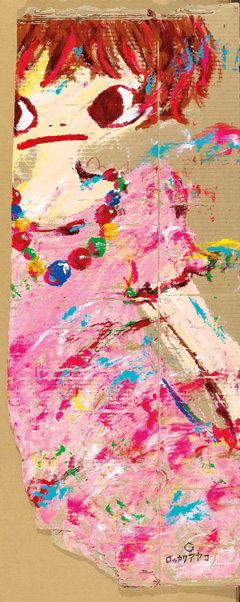
“The hand directs where the fingers point. They are more powerful than words.” She is a self-taught painter, without conventional views or grand theories on aestheticism as the foundation of her creations. Instead, she grew up under the influence of Japanese contemporary comics and animation. That, together with her acute observation and intricate feelings that she was born with, makes her a person who simply enjoys sketching.
She paints on abandoned cardboard. However, her improvisational, street-artlike, and arte povera characteristics do not seem to meet the expectations of the art market. After all, most collectors prefer paintings on canvas. Nevertheless, when it comes to her artistic expression and originality, the cardboard reflects Rokkaku’s free sketching spirit, which has a value that cannot be overlooked. The works she exhibited in the three GEISAIs were all painted on cardboard. The book Colours in My Hands, published by Galerie Delaive, contained the following passage that reflected Rokkaku’s change of mind about this:
“Some people find little change in my works from the early stage for this stage, but it was a big transformation to me to start painting on canvas and exhibit the works in order one by one.”
In daily life, cardboard is a ubiquitous material. It is light and can stand up straight by itself. When dabbing it with hands filled with acrylic pigments, she can feel the warm sense of touch. Or, the rents torn in the cardboard and the feeling of coloring are both what the painter is fond of. Occasionally, she still paints this way.
Under arrangement by the Gallery Delaive, Rokkaku started conducting live painting performances at major art exhibitions around the world, including Art Basel, Art Basel Miami, and Art Taipei. Like a performance artist, she was barehanded and bare-footed, using her primal instinct to create. She thus described her feelings of live painting: “It’s amazing to paint on something for [sic] bigger than your body. As I go back and forth between the edges of the huge canvas, the big bunch of colours start[s] to flow into my body. I try to gather them in my hand and let them spin.”
Her ample creativity won her the opportunity to be exhibited in international galleries. She has held solo exhibitions at the Galerie AAA in Paris (2006), at the Gallery Delaive in Amsterdam, Netherlands, (2007, 2008, 2009, 2010, 2015, 2016, 2018), at the Galerie Moderne in Silkeborg, Denmark (2007), at the Galerie Wild in Frankfurt, Germany (2007), at Guy Pieters Gallery in Knokke-Heist, Belgium (2009), at the Galerie Teo in Tokyo (2007), the Gallery Target in Tokyo (2014, 2017), and at Gallery Trax (2015) in Yamanashi Prefecture.
She has also been invited by museums and biennales to exhibit, including her solo exhibition at Kunsthal, a contemporary art museum in Rotterdam, Netherlands (2011), a solo exhibition at Danubiana Meulensteen Art Museum in Slovakia (2012), a joint exhibition in Swatch Art Pavilion, Swatch Biennale Arte 2015, a joint exhibition at Kunsthal (2017), and a joint exhibition at Volkenkunde Museum Leiden (2017).
Because Rokkaku’s agent gallery is in Amsterdam, the gallery owner found her a studio in Amsterdam to facilitate her creations and exhibitions. The studio was in a converted warehouse in the city center. During the day, daylight shone through the frosted glass, making the studio very bright. The pace of life and the sunshine in the City of Tulips also brightened up the colors on her palette.
Sometime between 2010 and 2011, she moved her studio to Berlin, Germany, for no specific reason. Her studio in Berlin was small. She suppressed her desires, slowed down her pace, and left more time for herself. She also owned a private living space a 10-minute walk from the studio. In Berlin, a city where old and new buildings coexist, culture shock substantially influenced her creation, and her desire to create was intensified.
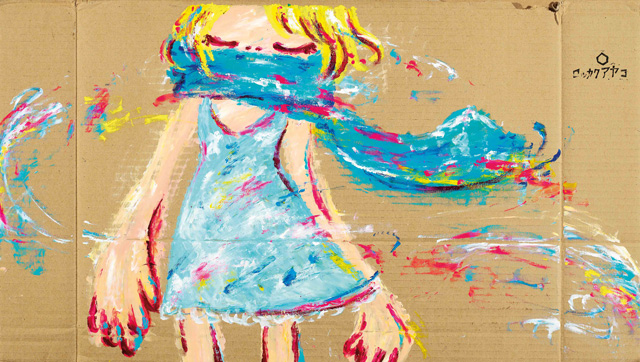
UNIQUE PAINTING CHARACTERISTICS AND STYLE
From self-analysis, Rokkaku listed three characteristics of her paintings: “plain scribbling,” “the act of getting out something inside me,” and “kid’s drawing.” The kid-like drawing was to practice lines, but she found scribbling to be fun. At first, she painted whatever she saw and then repeatedly practiced painting the subjects in her sketchbook. When she paints, she almost never studies but paints with intuition.
The major themes throughout her painting history are girls and children, and she often portrays them in close-ups. The figures in her painting are often unsmiling. Their eyes may be opened wide and their lips pressed together, or they may look angry. She said her figures went from two sets of extremes: “escaping and chasing” or “looking away and staring.” Most of the main figures in her paintings are walking in large strides. Other common elements in her paintings are repetitive random sketches and animals. Having elongated arms or overly large eyes, bright colors or simplified details, they are all influenced by Japanese animation culture.
Sometimes, the pictures she portrays indicate darkness and insecurity. The feelings of loneliness or consciousness of death in her memories hide in her color paintings in the forms of ghosts of rabbits or skulls. Although dark, they are harmless, and even kind of cute. Even when they stare with wide eyes, sneer, give sidelong looks, or are naughty and smoke, they still appear to be therapeutic and gentle, not giving the viewer any visual impact or anxiety.
When she painted on cardboard in the past, she was used to placing the paper flat on the floor. Later, when she first turned to canvas and saw pigments flowing down from the erected canvas, she felt delighted. She saw the pigments obeying the law of gravity and wanted to capture that sense of fluidity in her work. She not only painted with her bare hands, without brushes and without drafting; she also often faced her canvas barefoot, letting her hands and body participate in the creation.
In 2010, the first animation Rokkaku was part of, About Us, was released. The film, based on a script by Kentaro Kawaguchi, was supervised and directed by Michinori Saigo. The story describes a girl connecting past and future worlds, a story awaiting everyone to complete it together. For this film, Rokkaku painted over 200 paintings. Although some of the paintings were not selected, the sheer volume of work reflected her diligence and dedication. The drafts of the paintings of the animation were created with a method completely different from her past creation methods. This time, she had to integrate the setting of the plot, background, music, and image settings and exert a potential she had never been able to comprehend. Because of Rokkaku’s unique color presentation, this film seemed elegant and
gentle.
In connection with the release of the animation, Rokkaku held exhibitions titled “About Us” in both Tokyo and Amsterdam, and at both sites, she gave live performances, painting a three-dimensional house built with cardboard. Animation, behavioral performances, and 3D creations all foretold that she would attempt to create with diverse materials. In 2011, the scope of her creations expanded to sculpture, as if the girl portraits and animals on a gigantic scale were walking out of the canvas. In addition to a futuristic world with dream-like qualities, she attempted abstract painting. In fact, abstract patterns had appeared in the backgrounds of her portraits. She used improvised sketching and conducted interesting experiments with colors and forms.
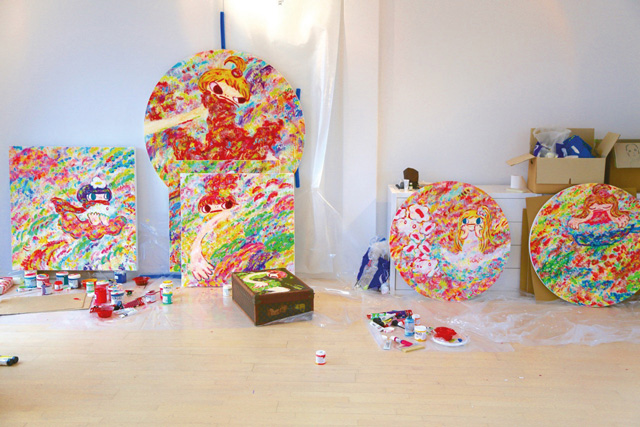
INQUIRIES ON THE ART MARKET CONTINUE TO INCREASE
In Spring 2018, Rokkaku became an artist with an extremely high rate of inquiries on Asian markets. Her works at auctions in Tokyo, Hong Kong, and Taipei all attracted fierce bidding. The art market in Japan is relatively conservative; the collectors tend to be lukewarm about works by young artists. However, to date, the three Rokkaku works sold at the highest prices all appeared in auctions in Tokyo in April and July of 2018. Auctions in Hong Kong and Taipei also had collectors bidding from Japan. Obviously, Japanese collectors are eager to obtain works by Rokkaku.
Currently, Rokkaku’s works are exclusively represented by Gallery Delaive in the Netherlands. Even if Japanese painters want to obtain her work first-hand, they must fly to Europe for it. In 2017, when Rokkaku’s works were licensed to be exhibited at Gallery Target in Tokyo, her new works all sold out on the opening day. If collectors want to purchase close-up, big-headed girl portraits when galleries are not selling their stocks, they can only hope to get lucky at auctions.
Before the autumn auction of 2017, her #50 acrylic oil paintings at auctions typically sold for US$20,000 (approximately NT$0.6 million). After the spring auction of 2018, paintings of the same size sold for at least US$50,000 to 70,000 (approximately NT$1.5–2.1 million). In the past, her works on cardboard cost around US$4–6 thousand (approximately NT$120,000–180,000), and they have increased in value to an average of US$10,000–15,000 (NT$0.3–0.45 million) or higher.
According to statistics from Artprice, in 2017, the number of transactions for Rokkaku’s works at auctions was 19, with a transaction amount of approximately US$242,273 (excluding the buyer’s service fee) (approximately NT$7.27 million). In 2018, as of August, the number was 27, with a transaction amount reaching US$738,986 (excluding the buyer’s service fee) (approximately NT$22.17 million). The transactions in the first half of the calendar year alone have far exceeded the total amount of the previous calendar year.
In 2018, Rokkaku is 36 years old, still in her prime and full of creative energy. She now rotates among living and creating in Berlin, Amsterdam, Tokyo, and Porto, Portugal. Furthermore, she consistently hosts exhibitions and publishes new works. Since 2001, she has created a large body of work. This rising star has been shining on the international art scene. In the future, she will continue to create, and the prices of her works will continue to rise. Let us wait in anticipation.
